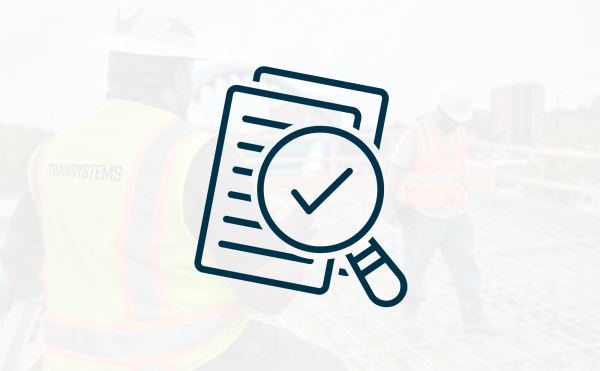REALIZING VALUE BEFORE CONSTRUCTION BEGINS
Prevent unnecessary project costs and streamline construction with a constructability review from TranSystems.
A constructability review is one of the most effective tools for mitigating risk, a major factor in a contractor’s bid that increases costs. When assembling a bid, a contractor factors in size, scope, location, subsurface conditions, timing, phasing, materials, labor, permit requirements and more. Once all the controllable factors are accounted for, the contractor then looks at risk. And the factors that contribute to risk include:
- Vague descriptions in the plans or contract
- Unusual bid items
- Unusual ways items are being bid
- Uncommon construction practices
- Unrealistic timeframes or completion dates
- Missing information or lack of details about operations required by the contact
- Costly, poor or restricted access to jobsites
- Contradictory typicals or detail
- Utility conflicts
The contractor will adjust their bid to account for these risks in order to be covered for a worst case scenario.
A constructability review, though, can help change the way a contractor bids your project by adding details or suggesting changes that eliminate risk, applying industry standards to construction, eliminating redundancies, or adjusting how items are paid for – which in turn allows the contractor to better identify overall costs.
A GOOD CONSTRUCTABILITY REVIEW IS ALL-ENCOMPASSING
A constructability review evaluates the feasibility, efficiency and practicality of a project’s design plans, specifications, and estimates before construction begins. The goal is to identify potential issues that may occur during construction and to find opportunities, if any, to streamline schedules and reduce costs. The primary purposes are to:
- Identify issues
- Standardize construction methods
- Enhance coordination
- Enhance safety
- Mitigate risks
- Refine cost estimates
- Refine schedules
- Consider future maintenance
With TranSystems, a constructability review can encompass nearly every step ahead of construction: concept development, project design, project phasing, contract assembly and plan layout.
WHEN ARE CONSTRUCTABILITY REVIEWS PERFORMED?
At TranSystems, we conduct constructability reviews at the concept stage, at the design stage and during contract assembly.
Concept Stage: A constructability review can be especially helpful at the concept stage, reviewing what the designer and you have in mind for a project before any plans are drawn up. At this stage, a constructability review takes a high level look at the project:
- Is the alignment the best alignment?
- Can the alignment be shifted to avoid risk areas such as utilities, complicated or costly right- of-way claims, the existence and proximity to wetlands and streams?
- How will traffic be handled and affected during construction?
- Are interim completion dates realistic?
- Could an alternate design speed up construction?
A constructability review during this early stage is perhaps the most beneficial to owners.
Design Stage: Most often, a constructability review occurs during the design stage, once plans are drawn up. At this point, the review examines specific ways to save time, money and resources while still achieving project goals. A constructability review identifies:
- Potential complexities in design that can be eliminated making construction more straightforward, quicker, or in-line with standard practices.
- Conflicting typicals, details, or notes on the plans.
- Areas where more details are needed to clearly show a contractor what is expected.
- Phasing overlaps such as the room between an existing and new structure versus the needed room to construct.
- The need for staging areas or lay down yards.
- Unnecessary project phases.
The list of possible areas that can be bettered via a constructability review is almost endless and is unique to every set of plans or contract.
Contracting: A perfect set of plans and a weak contract does not equal project success. It is important to do a constructability review of contracts to evaluate the timeframes allotted to the contractor. For example, if there is a completion time of 30 days with a penalty of $1,000 per extra day to set 50 boxes in the contract, this would be flagged because it would be virtually impossible to accomplish with a normal crew. A contractor might even inflate their bid to account for the anticipated penalties. This item would be caught in a constructability review, and a realistic completion date could be requested thus allowing the contractor to provide a more accurate bid. A constructability review during the contract stage ensures alignment of schedules, identifies special provisions and establishes agreement upon enforceable intermediate completion dates.
A constructability review at this stage also helps to identify possible risks in bid items. For example, lump sum items can sometimes seem like the way to go at first blush when in reality lump sum should be used more strategically. Items such as lump sum traffic control and lump sum erosion all have their place. A constructability review can help identify when lump sum will save time or money or when in reality it is introducing risk to the contractor.
Constructability reviews consider the unique variables of every project and help give the owner a comprehensive picture of risks and costs.
GOOD CONSTRUCTABILITY REVIEWS TAKE A TEAM APPROACH
An initial project review ideally includes the project owner, design team, right-of-way team, utility engineers and environmental units. This way, all the major aspects of a project can be reviewed and discussed by professional staff to identify areas for improvement. Sometimes this can happen in a group setting; sometimes, the project manager conducting the review will visit with each stakeholder in turn to discuss issues. It depends on the size, scope and nature of the project. As a project owner, the constructability review helps ensure that the information you give out to the public and stakeholders is as accurate as possible.
REPORTING RECOMMENDATIONS NOT REQUIREMENTS
With a constructability review, TranSystems delivers and presents a report focusing on those recommendations that will allow you as an owner to present a set of plans and a contract for bid that is realistic, free of vague or complex drawings and clearly identifies how the work is to be performed and how contractors will be paid. This will allow for competitive bids that best represent the true cost of the project.
CASE STUDIES
Constructability reviews are built-in with TranSystems. Our experience with constructability reviews spans roadways, structures, greenways, sidewalks, traffic systems, stormwater management and more.
Buncombe County Saves $5 Million
The I-26 project in Buncombe County, North Carolina, originally called for an extensive traffic phasing plan along with many temporary structures such as drainage boxes, pipes and asphalt paving that would be installed and paid for – only to be removed later. A constructability review took an in-depth look at traffic phasing and found ways to eliminate temporary structures, reducing project costs by $5 million.
Orange County Saves $21 Million
RedHill in Orange County, CA abutment reconstruction project at I-405 initially had a project scope to remove a failing abutment fill and retaining walls. After a constructability review, it was realized that changing the plan to a horseshoe shaped confinement wall and smaller embankment fill would save significant costs. That review and analysis brought the project cost from $28 million down to $6.8 million.
Constructability reviews often deliver concrete benefits beyond the monetary. For example:
- Many temporary structures or easements can be eliminated in favor of acquiring permanent right-of-way, which also provides better access for ongoing maintenance.
- Lengthy stage construction plans can be converted to single phase construction, allowing projects to be completed in much less time. This happens often on bridge replacements.
- Planned construction for bridge replacements often do not allow sufficient room for construction – for example, overlooking the right-of-way needed for staging large cranes to set beams.
Constructability reviews keep these vital details from becoming show stoppers or budget busters.
WITH TRANSYSTEMS CONSTRUCTABILITY REVIEWS ARE BUILT IN
Constructability reviews can be tailored to your project. For larger projects, an in-depth review can be essential because these projects often have multiple phases, traffic shifts and varied operations. For the average project, a scaled down review can be arranged to take less time and resources. At TranSystems, we feel that a constructability review will help you as the owner to give out accurate information to the public and to stakeholders. The review will help to eliminate project oversights and plans errors and redundancies – which in turn will produce a truer representation of costs in the bids you receive. Ultimately, It will save you time and money by eliminating delays during construction, reducing costly change orders, reducing final project claims and allowing for better project budgeting.
FOR MORE INFORMATION ON CONSTRUCTABILITY REVIEWS, PLEASE CONTACT:
Randy McKinney, PE, CPM Robert Zordani, PE
Asheville, NC Office Lead Senior Highway Construction Engineer
rmckinney@transystems.com razordani@transystems.com



